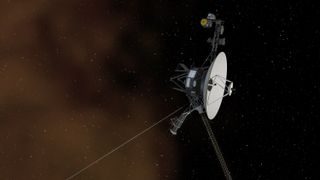The most distant spacecraft in the solar system — Where are they now?
![]()
The most distant spacecraft in the solar system — Where are they now?
By Briley Lewis
published 3 days ago

An artist’s depiction of one of the twin Voyager probes. (Image credit: NASA / JPL)
Humans have been flinging things into deep space for 50 years now, since the 1972 launch of Pioneer 10. We now have five spacecraft that have either reached the edges of our solar system or are fast approaching it: Pioneer 10, Pioneer 11, Voyager 1, Voyager 2 and New Horizons.
Most of these probes have defied their expected deaths and are still operating long beyond their original mission plans. These spacecraft were originally planned to explore our neighboring planets, but now they’re blazing a trail out of the solar system, providing astronomers with unique vantage points in space — and they’ve been up to a lot in 2022.
Voyagers 1 and 2
The Voyager missions celebrated a very special anniversary this year: 45 years of operations. From close fly-bys of the outer planets to exploring humans’ furthest reach in space, these two spacecraft have contributed immensely to astronomers’ understanding of the solar system.
Voted Most Effective Metabolism SupplementCelebrity Secret
Related: Voyager: 15 incredible images of our solar system captured by the twin probes (gallery)
Click here for more Space.com videos…CLOSE
0 seconds of 2 minutes, 43 secondsVolume 0%
PLAY SOUND
Their main project now is exploring where the sun‘s influence ends, and other stars’ influences begin. Voyager 1 crossed the heliopause, the boundary where the sun’s flow of particles ceases to be the most important influence, in 2012 with Voyager 2 following close after, in 2018.
“Voyager 1 has now been in interstellar space for a decade…and it’s still going, still going strong,” Linda Spilker, Voyager project scientist and a planetary scientist at NASA’s Jet Propulsion Laboratory (JPL) in California, told Space.com.
The mission team hit one major hiccup this year, when the spacecraft began sending home garbled information about its location. The engineers found the cause — the spacecraft was using a bad piece of computer hardware when it shouldn’t have — and restored operations.
These kinds of incidents are to be expected with an aging spacecraft, though. The team is also actively managing the power supply onboard each spacecraft, which is dwindling each year as the probes’ radioactive generators grow increasingly inefficient. This year, mission personnel turned off heaters keeping a number of scientific instruments on board warm in the harsh, cold environment of space — and, much to everyone’s surprise, those instruments are still working perfectly well.

The cameras may have been turned off decades ago, but the spacecrafts’ other instruments are collecting data on the plasma and magnetic fields from the sun at a great distance away from the star itself. Because particles of the solar wind — the constant stream of charged particles flowing off the sun — take time to travel such a long way, distant observations allow scientists to see how changes from the sun propagate throughout our cosmic neighborhood.
The edges of the solar system have been full of surprises, too. It would make sense that plasma from the sun becomes more sparse and spread out as you move away from the center of the solar system, but in fact, the Voyagers have encountered much denser plasma after crossing the heliopause. Astronomers are still puzzled about that one.
“It’s just so amazing that even after all this time we continue to see the sun’s influence in interstellar space,” Spilker said. “I’m looking forward to Voyager continuing to operate, perhaps reaching the 50th anniversary.”
Pioneers 10 and 11
The Pioneer spacecraft hold a special place in space history because of their role as, you guessed it, pioneers. Unfortunately, these mile

































![Lieutenant-Colonel Robert Rogers (7 November 1731 – 18 May 1795) was a British Army officer and frontiersman. Born in Methuen, Massachusetts, he fought in King George’s War, the French and Indian War and the American Revolutionary War. During the French and Indian War, Rogers raised and commanded Rogers’ Rangers, a ranger unit trained for carrying out asymmetric warfare.[2][3](https://www.cowboyron.com/wp-content/uploads/2022/05/1262463_580743685323360_2133853937_o1-1-150x150.jpg)
















![Billie Joe Armstrong & Norah Jones – Silver Haired Daddy Of Mine [Music Video]](https://www.cowboyron.com/wp-content/uploads/2022/11/Al_St._John1-100x100.jpg)























